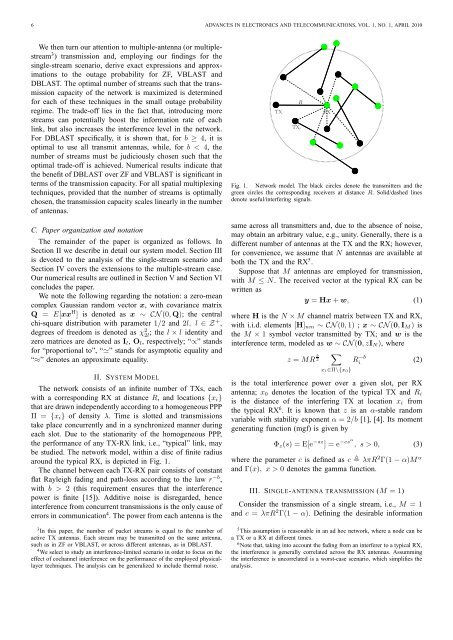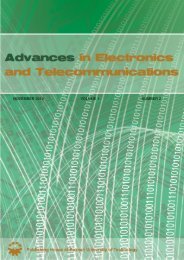channel - Advances in Electronics and Telecommunications
channel - Advances in Electronics and Telecommunications
channel - Advances in Electronics and Telecommunications
Create successful ePaper yourself
Turn your PDF publications into a flip-book with our unique Google optimized e-Paper software.
6 ADVANCES IN ELECTRONICS AND TELECOMMUNICATIONS, VOL. 1, NO. 1, APRIL 2010<br />
We then turn our attention to multiple-antenna (or multiplestream<br />
3 ) transmission <strong>and</strong>, employ<strong>in</strong>g our f<strong>in</strong>d<strong>in</strong>gs for the<br />
s<strong>in</strong>gle-stream scenario, derive exact expressions <strong>and</strong> approximations<br />
to the outage probability for ZF, VBLAST <strong>and</strong><br />
DBLAST. The optimal number of streams such that the transmission<br />
capacity of the network is maximized is determ<strong>in</strong>ed<br />
for each of these techniques <strong>in</strong> the small outage probability<br />
regime. The trade-off lies <strong>in</strong> the fact that, <strong>in</strong>troduc<strong>in</strong>g more<br />
streams can potentially boost the <strong>in</strong>formation rate of each<br />
l<strong>in</strong>k, but also <strong>in</strong>creases the <strong>in</strong>terference level <strong>in</strong> the network.<br />
For DBLAST specifically, it is shown that, for b ≥ 4, it is<br />
optimal to use all transmit antennas, while, for b < 4, the<br />
number of streams must be judiciously chosen such that the<br />
optimal trade-off is achieved. Numerical results <strong>in</strong>dicate that<br />
the benefit of DBLAST over ZF <strong>and</strong> VBLAST is significant <strong>in</strong><br />
terms of the transmission capacity. For all spatial multiplex<strong>in</strong>g<br />
techniques, provided that the number of streams is optimally<br />
chosen, the transmission capacity scales l<strong>in</strong>early <strong>in</strong> the number<br />
of antennas.<br />
C. Paper organization <strong>and</strong> notation<br />
The rema<strong>in</strong>der of the paper is organized as follows. In<br />
Section II we describe <strong>in</strong> detail our system model. Section III<br />
is devoted to the analysis of the s<strong>in</strong>gle-stream scenario <strong>and</strong><br />
Section IV covers the extensions to the multiple-stream case.<br />
Our numerical results are outl<strong>in</strong>ed <strong>in</strong> Section V <strong>and</strong> Section VI<br />
concludes the paper.<br />
We note the follow<strong>in</strong>g regard<strong>in</strong>g the notation: a zero-mean<br />
complex Gaussian r<strong>and</strong>om vector x, with covariance matrix<br />
Q = E[xxH ] is denoted as x ∼ CN (0, Q); the central<br />
chi-square distribution with parameter 1/2 <strong>and</strong> 2l, l ∈ Z + ,<br />
degrees of freedom is denoted as χ 2 2l<br />
; the l × l identity <strong>and</strong><br />
zero matrices are denoted as Il, Ol, respectively; “∝” st<strong>and</strong>s<br />
for “proportional to”, “≃” st<strong>and</strong>s for asymptotic equality <strong>and</strong><br />
“≈” denotes an approximate equality.<br />
II. SYSTEM MODEL<br />
The network consists of an <strong>in</strong>f<strong>in</strong>ite number of TXs, each<br />
with a correspond<strong>in</strong>g RX at distance R, <strong>and</strong> locations {xi}<br />
that are drawn <strong>in</strong>dependently accord<strong>in</strong>g to a homogeneous PPP<br />
Π = {xi} of density λ. Time is slotted <strong>and</strong> transmissions<br />
take place concurrently <strong>and</strong> <strong>in</strong> a synchronized manner dur<strong>in</strong>g<br />
each slot. Due to the stationarity of the homogeneous PPP,<br />
the performance of any TX-RX l<strong>in</strong>k, i.e., “typical” l<strong>in</strong>k, may<br />
be studied. The network model, with<strong>in</strong> a disc of f<strong>in</strong>ite radius<br />
around the typical RX, is depicted <strong>in</strong> Fig. 1.<br />
The <strong>channel</strong> between each TX-RX pair consists of constant<br />
flat Rayleigh fad<strong>in</strong>g <strong>and</strong> path-loss accord<strong>in</strong>g to the law r −b ,<br />
with b > 2 (this requirement ensures that the <strong>in</strong>terference<br />
power is f<strong>in</strong>ite [15]). Additive noise is disregarded, hence<br />
<strong>in</strong>terference from concurrent transmissions is the only cause of<br />
errors <strong>in</strong> communication 4 . The power from each antenna is the<br />
3 In this paper, the number of packet streams is equal to the number of<br />
active TX antennas. Each stream may be transmitted on the same antenna,<br />
such as <strong>in</strong> ZF or VBLAST, or across different antennas, as <strong>in</strong> DBLAST.<br />
4 We select to study an <strong>in</strong>terference-limited scenario <strong>in</strong> order to focus on the<br />
effect of co<strong>channel</strong> <strong>in</strong>terference on the performance of the employed physicallayer<br />
techniques. The analysis can be generalized to <strong>in</strong>clude thermal noise.<br />
R<br />
TX RX<br />
TXi<br />
Fig. 1. Network model. The black circles denote the transmitters <strong>and</strong> the<br />
green circles the correspond<strong>in</strong>g receivers at distance R. Solid/dashed l<strong>in</strong>es<br />
denote useful/<strong>in</strong>terfer<strong>in</strong>g signals.<br />
same across all transmitters <strong>and</strong>, due to the absence of noise,<br />
may obta<strong>in</strong> an arbitrary value, e.g., unity. Generally, there is a<br />
different number of antennas at the TX <strong>and</strong> the RX; however,<br />
for convenience, we assume that N antennas are available at<br />
both the TX <strong>and</strong> the RX 5 .<br />
Suppose that M antennas are employed for transmission,<br />
with M ≤ N. The received vector at the typical RX can be<br />
written as<br />
y = Hx + w, (1)<br />
where H is the N × M <strong>channel</strong> matrix between TX <strong>and</strong> RX,<br />
with i.i.d. elements [H]nm ∼ CN (0, 1) ; x ∼ CN (0, IM ) is<br />
the M × 1 symbol vector transmitted by TX; <strong>and</strong> w is the<br />
<strong>in</strong>terference term, modeled as w ∼ CN (0, zIN), where<br />
z = MR b<br />
2<br />
�<br />
xi∈Π\{x0}<br />
R −b<br />
i<br />
is the total <strong>in</strong>terference power over a given slot, per RX<br />
antenna; x0 denotes the location of the typical TX <strong>and</strong> Ri<br />
is the distance of the <strong>in</strong>terfer<strong>in</strong>g TX at location xi from<br />
the typical RX 6 . It is known that z is an α-stable r<strong>and</strong>om<br />
variable with stability exponent α = 2/b [1], [4]. Its moment<br />
generat<strong>in</strong>g function (mgf) is given by<br />
(2)<br />
Φz(s) = E[e −sz ] = e −csα<br />
, s > 0, (3)<br />
where the parameter c is def<strong>in</strong>ed as c � λπR 2 Γ(1 − α)M α<br />
<strong>and</strong> Γ(x), x > 0 denotes the gamma function.<br />
III. SINGLE-ANTENNA TRANSMISSION (M = 1)<br />
Consider the transmission of a s<strong>in</strong>gle stream, i.e., M = 1<br />
<strong>and</strong> c = λπR 2 Γ(1 − α). Def<strong>in</strong><strong>in</strong>g the desirable <strong>in</strong>formation<br />
5 This assumption is reasonable <strong>in</strong> an ad hoc network, where a node can be<br />
a TX or a RX at different times.<br />
6 Note that, tak<strong>in</strong>g <strong>in</strong>to account the fad<strong>in</strong>g from an <strong>in</strong>terferer to a typical RX,<br />
the <strong>in</strong>terference is generally correlated across the RX antennas. Assumm<strong>in</strong>g<br />
the <strong>in</strong>terference is uncorrelated is a worst-case scenario, which simplifies the<br />
analysis.







